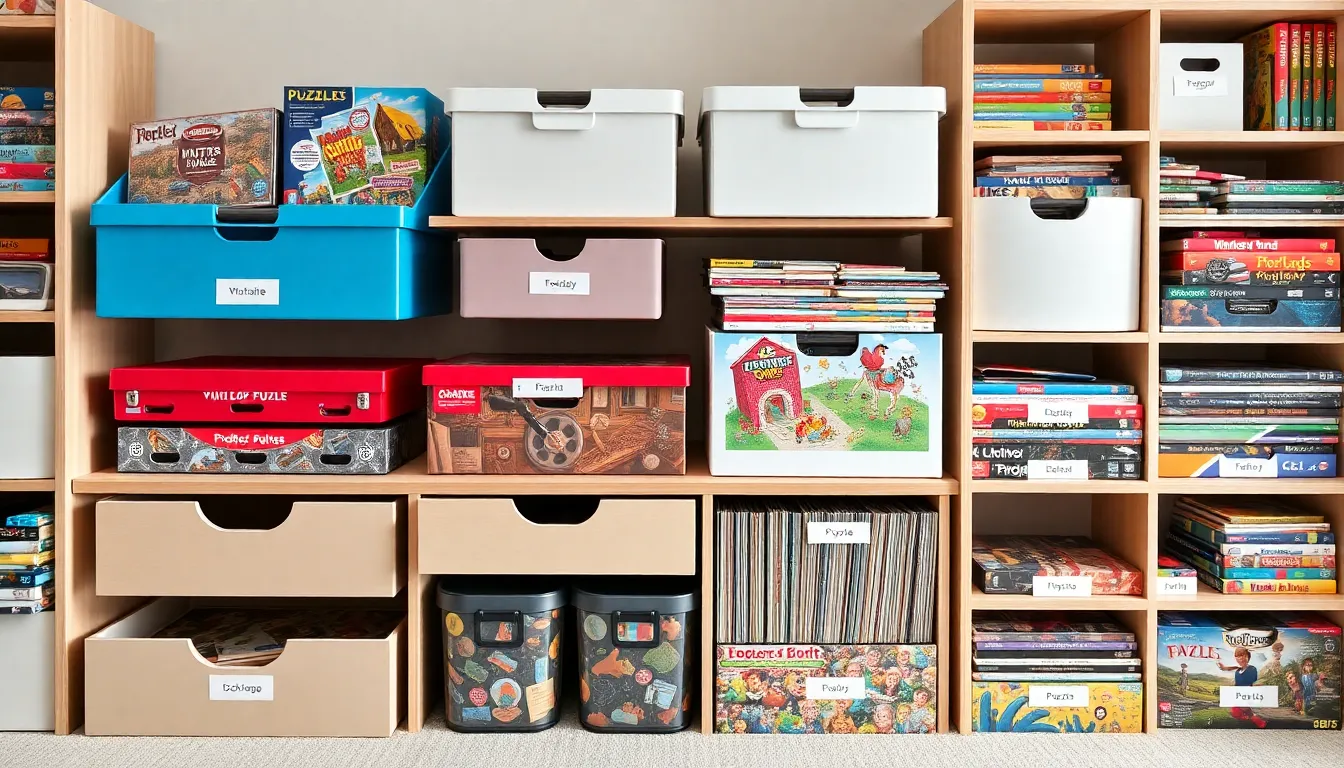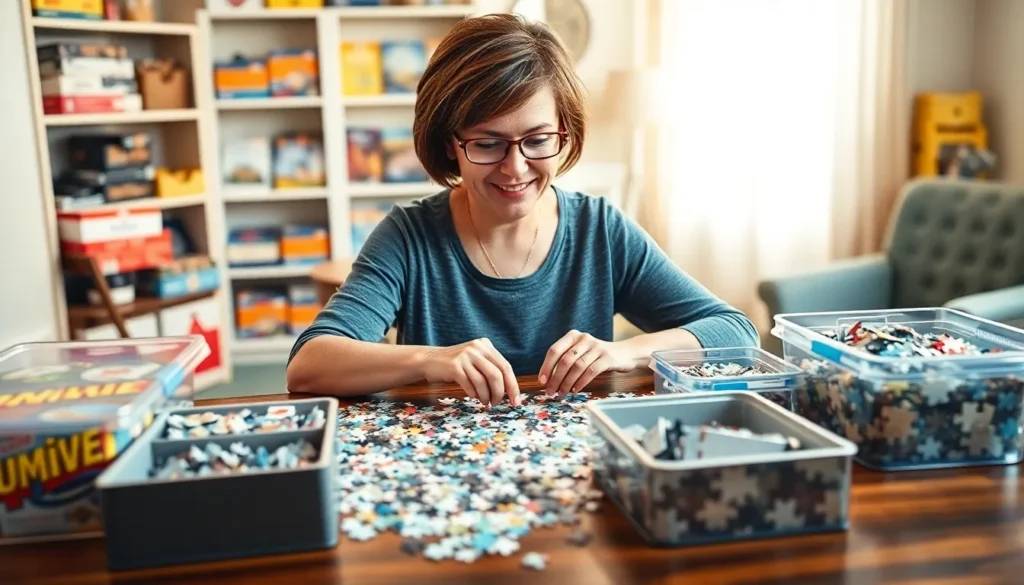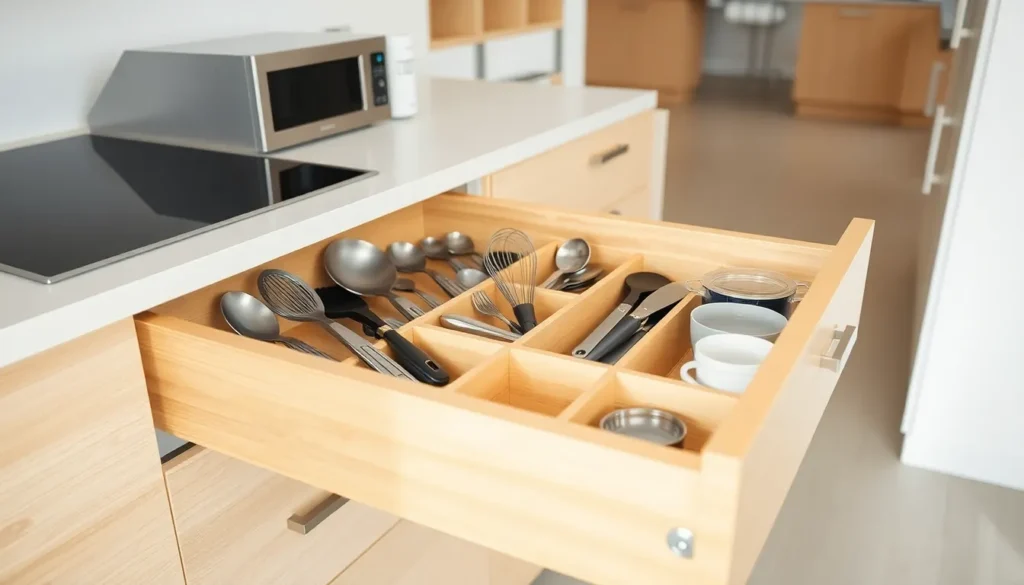Puzzles have a unique way of captivating minds and providing hours of entertainment. Whether it’s a jigsaw, crossword, or Sudoku, these brain-teasers not only challenge problem-solving skills but also offer a satisfying sense of accomplishment. However, as puzzle enthusiasts know, keeping them organized can be a challenge in itself.
An organized puzzle collection enhances the experience, making it easier to find that perfect challenge when the mood strikes. With a few simple strategies, anyone can transform their chaotic puzzle stash into a well-ordered haven. From clever storage solutions to effective sorting methods, organizing puzzles can elevate enjoyment and streamline the process. Let’s explore how to create an efficient system that keeps the fun going without the hassle.
Table of Contents
ToggleBenefits of Organizing Puzzles
Organizing puzzles offers numerous advantages that enhance the overall puzzle-solving experience. Properly arranged collections improve accessibility and heighten enjoyment while engaging various cognitive and emotional benefits.
Enhancing Cognitive Skills
Organizing puzzles stimulates critical thinking, problem-solving, and memory recall. Sorted puzzles allow for easier and quicker access to specific types, fostering effective strategies during solving. Engaging with different puzzle challenges enhances pattern recognition and analytical skills, sharpening cognitive functions over time. Regular puzzle-solving strengthens neural connections, contributing to overall mental agility.
Promoting Relaxation and Mindfulness
Organizing puzzles promotes relaxation by creating a structured environment, minimizing frustration when looking for a specific puzzle. A calm, organized space encourages a focused mindset, enabling mindfulness during the puzzle-solving process. The repetitive nature of sorting and assembling pieces can serve as a form of meditation, reducing stress levels and enhancing overall well-being.
Essential Tools for Organizing Puzzles

Organizing puzzles requires the right tools to streamline the process. Implementing effective storage solutions, alongside sorting and labeling techniques, enhances accessibility and encourages puzzle engagement.
Puzzle Storage Solutions
Utilizing appropriate storage options simplifies the organization of puzzles. Consider these solutions:
- Puzzle Boxes: Choose durable, stackable boxes specifically designed for puzzle storage. Sizes vary by puzzle piece counts, accommodating 300 to 2000 pieces.
- Drawers: Utilize shallow drawers to store completed puzzles flat. Drawer dividers prevent accidental mixing, saving time.
- Binders: Opt for binders with plastic sheet protectors for compact sorting of flat puzzles or puzzle designs. Each puzzle can be easily added, removed, or admired.
- Shelving Units: Use open shelving to create designated areas for different puzzle categories. Label shelves by genre or difficulty level, ensuring easy access.
- Storage Bags: Employ zippered storage bags to keep bagged puzzles safe and organized. These bags are portable, so they suit travel or puzzle gatherings.
Sorting and Labeling Techniques
- Piece Count Organization: Sort puzzles by piece count, creating categories such as 500, 1000, or 1500 pieces. This method helps select puzzles based on desired complexity.
- Theme Grouping: Group puzzles by themes, like landscapes, animals, or art. This approach allows quick identification of preferred styles.
- Color Coding: Use colored labels for each category. For example, assign specific colors to different themes or difficulty levels, instantly signaling contents.
- Inventory System: Maintain a digital inventory with details like piece counts, themes, and locations. This can streamline puzzle selection, especially for large collections.
- Labeling: Clearly label boxes and containers with the puzzle name, piece count, and a thumbnail image of the completed puzzle. This visual aid aided identification when browsing through options.
Steps to Organize Puzzles Effectively
Organizing puzzles effectively enhances the experience of puzzle enthusiasts. Implementing systematic methods leads to improved accessibility and enjoyment.
Sorting by Size and Type
Sorting puzzles by size and type aids in quick identification and retrieval.
- Group by piece count: Set apart puzzles based on the number of pieces, like 100, 500, or 1000 pieces. This practice streamlines the selection process for those seeking specific challenges.
- Categorize by theme: Organize puzzles based on themes, such as landscapes, animals, or abstract art. Thematic sorting allows for easier navigation when choosing a puzzle that fits the mood or occasion.
- Differentiate puzzle types: Distinguish between jigsaws, crosswords, and other formats. Keeping various puzzle types separate makes it convenient to find the preferred puzzle style in a crowded collection.
Creating a Puzzle Area
Establishing a dedicated puzzle area enhances focus and enjoyment during puzzle-solving sessions.
- Allocate a specific space: Designate a table or shelf exclusively for puzzles. A clutter-free zone provides an inviting space to work on puzzles without distractions.
- Ensure proper lighting: Utilize bright lighting, such as lamps or overhead lights, to enhance visibility of puzzle pieces. Good lighting minimizes eye strain and aids in recognizing piece patterns.
- Incorporate organizing tools: Utilize containers, trays, or bags to keep pieces sorted within the designated area. These tools help manage loose pieces and support efficient puzzle assembly.
Maintaining Your Organized Puzzles
Maintaining an organized puzzle collection hinges on consistent management strategies. Following these practices ensures puzzles remain accessible while keeping them in top condition.
- Regularly Evaluate
Regularly evaluate the collection for any unused or damaged puzzles. This evaluation enhances space efficiency and promotes a more enjoyable selection.
- Replace Materials
Replace any damaged containers or tools. Ensuring all storage solutions remain durable minimizes future disorganization.
- Update Inventory
Update the digital inventory or labeling system after acquiring new puzzles. This keeps all information current, facilitating easy identification during future puzzle sessions.
- Implement a Routine
Implement a routine for organizing puzzles after each session. Sorting and storing pieces immediately reduces clutter and preserves the integrity of the collection.
- Organize by Frequency
Organize puzzles by frequency of use. Place frequently enjoyed puzzles in convenient locations while storing less frequently used ones in less accessible areas.
- Create Seasonal Categories
Create seasonal categories to keep the collection dynamic. This method engages interest and encourages revisiting puzzles relevant to specific times of the year.
- Establish a Maintenance Schedule
Establish a maintenance schedule to review the organization system periodically. This schedule supports sustainability and adaptability of the organization method.
- Encourage Shared Engagement
Encourage shared engagement with family and friends. Group puzzle sessions promote variety and offer opportunities for collaboration in maintaining the organized system.
By following these strategies, puzzle enthusiasts can sustain an organized collection, facilitate a smoother solving process, and enhance enjoyment for both themselves and others.
An organized puzzle collection not only simplifies the search for favorite puzzles but also enriches the overall experience. By implementing effective storage and sorting methods, puzzle enthusiasts can create a space that promotes focus and enjoyment. The benefits extend beyond mere accessibility; an organized environment fosters relaxation and stimulates cognitive skills.
Regular maintenance and strategic categorization keep the collection dynamic and engaging. Encouraging shared puzzle-solving experiences with family and friends adds an extra layer of enjoyment. Embracing these organization strategies transforms puzzle-solving from a chaotic endeavor into a fulfilling and satisfying activity.













